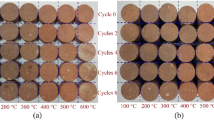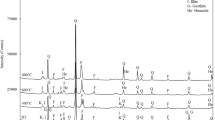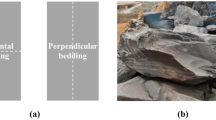Abstract
Uniaxial compression tests were carried out on bedded sandstone to explore the effect of exposure to high temperatures on the physical and mechanical properties of the specimens. The influences of testing temperature and bedding orientation on the physical and mechanical properties and failure behaviors of the bedded sandstone were analyzed. The results show that for sandstone with a constant bedding orientation, as the temperature increases, the P wave velocity first increases and then decreases, while the mass and density decrease. The mechanical properties of bedded sandstone, including its compressive strength and elastic modulus, first increase and then decrease with increasing temperature, and a thermal temperature of 400 °C was identified as the transition temperature, above which considerable changes in the mechanical properties were observed. In addition, the P wave velocity, strength, and elastic modulus also varied with increasing bedding orientation, which indicated that the bedded sandstone exhibits anisotropy in its P wave velocity, strength, and elastic modulus. The P wave velocity gradually increases with increasing inclination angle, and the fluctuation in the anisotropic degree of the P wave velocity remains small as the temperature increases. The strength and elastic modulus of the bedded sandstone exhibit U-shaped variations with increasing bedding orientation, and the anisotropy degree first increases and then decreases with increasing temperature. Furthermore, the failure modes are closely related to the designed heat treatment temperature and bedding orientation and can be generally classified into four categories: shearing across the rock matrix and bedding planes, shearing combined with tensile splitting, shearing along the bedding planes, and shearing combined with tensile splitting along the bedding planes. Finally, the effect of high temperatures on the mechanical properties of bedded sandstone was further revealed by means of SEM analysis from a microstructure point of view.



















Similar content being viewed by others
References
Ali E, Wu G, Zhao Z, Jiang W (2014) Assessments of strength anisotropy and deformation behavior of banded amphibolite rocks. Geotech Geol Eng 32(2):429–438
ASTM (2014) Standard test methods for compressive strength and elastic moduli of intact rock core specimens under varying states of stress and temperatures. ASTM designation D-7012
Chenevert ME, Gatlin C (1965) Mechanical anisotropies of laminated sedimentary rocks. J Soc Petrol Eng 5:67–77
Cho JW, Kim H, Jeon S, Min KB (2012) Deformation and strength anisotropy of Asan gneiss, Boryeong shale, and Yeoncheon schist. Int J Rock Mech Min Sci 50(2):158–169
Ding QL, Ju F, Mao XB, Ma D, Yu BY, Song SB (2016) Experimental investigation of the mechanical behavior in unloading conditions of sandstone after high-temperature treatment. Rock Mech Rock Eng 49(7):2641–2653
Donath FA (1961) Experimental study of shear failure in transversely isotropic rock. Geol Soc Am Bull 72:985–990
Esamaldeen A, Wu G, Zhao ZM, Jiang WX (2014) Assessments of strength anisotropy and deformation behavior of banded amphibolite rocks. Geotech Geol Eng 32(2):429–438
Gao Q, Tao J, Hu J, Yu X (2015) Laboratory study on the mechanical behaviors of an anisotropic shale rock [J]. J Rock Mech Geotech Eng 7(2):213–219
Horino FG, Ellickson M (1970) A method of estimating strength of rock containing planes of weakness. U.S. Bureau of Mines Report of Investigations. 7449. 26 p
Hu SC, Tan YL, Hui Z, Guo WY, Hu DW, Meng FZ et al (2017) Impact of bedding planes on mechanical properties of sandstone. Rock Mech Rock Eng 50(8):2243–2251
Huang YH, Yang SQ, Tian WL, Zhao J, Ma D, Zhang CS (2017) Physical and mechanical behavior of granite containing pre-existing holes after high temperature treatment. Arch Civ Mech Eng 17(4):912–925
Huang YH, Yang SQ, Tian WL (2019) Cracking process of a granite specimen that contains multiple pre-existing holes under uniaxial compression. Fatigue Fract Eng Mater Struct 42(6):1341–1356
ISRM (2007) The complete ISRM suggested methods for rock characterization, testing and monitoring: 1974–2006. In: Ulusay R, Hudson JA (eds) Suggested methods prepared by the ISRM commission on testing methods. Compilation arranged by the ISRM Turkish National Group, Ankara, 628 p
Jaeger JC (1960) Shear failure of anisotropic rocks. Geol Mag 97(1):65–72
Kahraman S (2001) A correlation between P-wave velocity, number of joints and Schmidt hammer rebound number [J]. Int J Rock Mech Min Sci 38(5):729–733
Khanlari G, Rafiei B, Abdilor Y (2015) Evaluation of strength anisotropy and failure modes of laminated sandstones. Arab J Geosci 8(5):3089–3102
Koesoemadinata, AP, McMechan, GA (2004) Effects of diagenetic processes on seismic velocity anisotropy in near-surface sandstone and carbonate rocks. Journal of Applied Geophysics 56 (3):165-176
Liu XS, Tan YL, Ning JG, Lu YW, Gu QH (2018) Mechanical properties and damage constitutive model of coal in coal-rock combined body. Int J Rock Mech Min Sci 110:140–150
Lü C, Sun Q, Zhang W, Geng J, Lu L (2017) The effect of high temperature on tensile strength of sandstone. Appl Therm Eng 111:573–579
Nasseri MHB, Rao KS, Ramamurthy T (2003) Anisotropic strength and deformational behavior of Himalayan schists. Int J Rock Mech Min Sci 40(1):3–23
Qin Z, Fu HL, Chen XX (2019) A study on altered granite meso-damage mechanisms due to water invasion-water loss cycles. Environ Earth Sci 78(14):428
Ranjith P, Viete G, Daniel R, Bai JC (2012) Transformation plasticity and the effect of temperature on the mechanical behaviour of Hawkesbury sandstone at atmospheric pressure. Eng Geol 151:120–127
Saeidi O, Vaneghi RG, Rasouli V, Gholami R (2013) A modified empirical criterion for strength of transversely anisotropic rocks with metamorphic origin. Bull Eng Geol Environ 72(2):257–269
Saeidi O, Rasouli V, Vaneghi RG, Gholami R, Torabi SR (2014) A modified failure criterion for transversely isotropic rocks. Geosci Front 5(2):215–225
Saroglou H, Tsiambaos G (2007) “Classification of anisotropic rocks”. Proc. 11th Int. Congress of Rock Mechanics. Lisbon, Portugal, vol.1, 191–196
Shen Y, Yang Y, Yang G, **n H, Ye W, You Z et al (2018) Damage characteristics and thermo-physical properties changes of limestone and sandstone during thermal treatment from −30 °C to 1000 °C. Heat Mass Transf 54(11):3389–3407
Shi L, Xu J (2014) Mechanical properties of Qinling biotite granite after high temperature treatment. Int J Rock Mech Min Sci 71:188–193
Sirdesai NN, Singh TN, Ranjith PG (2017) Effect of varied durations of thermal treatment on the tensile strength of red sandstone. Rock Mech Rock Eng 50(1):1–9
Sirdesai NN, Gupta T, Singh TN (2018) Studying the acoustic emission response of an Indian monumental sandstone under varying temperatures and strains. Constr Build Mater 168:346–361
Sirdesai NN, Mahanta B, Ranjith PG (2019a) Effects of thermal treatment on physico-morphological properties of Indian fine-grained sandstone. Bull Eng Geol Environ 78(2):883–897
Sirdesai NN, Singh A, Sharma LK (2019b) Development of novel methods to predict the strength properties of thermally treated sandstone using statistical and soft-computing approach. Neural Comput & Applic 21(7):2841–2867
Su H, **g H, Du M, Chen W (2016) Experimental investigation on tensile strength and its loading rate effect of sandstone after high temperature treatment. Arab J Geosci 9(13):616
Sun Q, Zhang W, Su T, Zhu S (2016) Variation of wave velocity and porosity of sandstone after high temperature heating. Acta Geophys 64(3):633–648
Wang X, Tian L (2018) Mechanical and crack evolution characteristics of coal–rock under different fracture-hole conditions: a numerical study based on particle flow code. Environ Earth Sci 77(8):297
Wang J, Ning JG, Qiu PQ, Yang S, Shang HF (2019) Microseismic monitoring and its precursory parameter of hard roof collapse in longwall faces: a case study. Geomech Eng 17(4):375–383
Yang SQ, Ranjith PG, **g HW, Tian WL, Ju Y (2017) An experimental investigation on thermal damage and failure mechanical behavior of granite after exposure to different high temperature treatments. Geothermics 65:180–197
Yin PF, Yang SQ (2018) Experimental investigation of the strength and failure behavior of layered sandstone under uniaxial compression and Brazilian testing. Acta Geophys 66(4):1–21
Yin DW, Chen SJ, Liu XQ, Ma HF (2018) Effect of joint angle in coal on failure mechanical behaviour of roof rock–coal combined body. Q J Eng Geol Hydrogeol 51(2):202–209
Yong MT, Ming CK, Juang CH (2006) An experimental investigation of the failure mechanism of simulated transversely isotropic rocks. Int J Rock Mech Min Sci 43(8):1163–1181
Zhang W, Qiang S, Hao S, Geng J, Chao L (2016) Experimental study on the variation of physical and mechanical properties of rock after high temperature treatment. Appl Therm Eng 98:1297–1304
Zhou ZL, Cai X, Ma D (2019) Water saturation effects on dynamic fracture behavior of sandstone. Int J Rock Mech Min Sci 114:46–61
Zhu ZN, Tian H, Jiang GS, Cheng W (2018) Effects of high temperature on the mechanical properties of Chinese marble. Rock Mech Rock Eng 51(6):1937–1942
Zuo J, Li Y, Zhang X, Zhao Z, Wang T (2018) The effects of thermal treatments on the subcritical crack growth of **dingshan sandstone at elevated high temperatures. Rock Mech Rock Eng (7):1–16
Acknowledgments
The authors would like to thank the Editor and the anonymous reviewers for their helpful and constructive comments.
Funding
This work is financially supported by National Natural Science Foundation of China (Nos. 51734009, 51904290) and the Natural Science Foundation of Jiangsu Province, China (BK20180663).
Author information
Authors and Affiliations
Corresponding author
Rights and permissions
About this article
Cite this article
Shi, X., **g, H., Yin, Q. et al. Investigation on physical and mechanical properties of bedded sandstone after high-temperature exposure. Bull Eng Geol Environ 79, 2591–2606 (2020). https://doi.org/10.1007/s10064-020-01729-7
Received:
Accepted:
Published:
Issue Date:
DOI: https://doi.org/10.1007/s10064-020-01729-7




